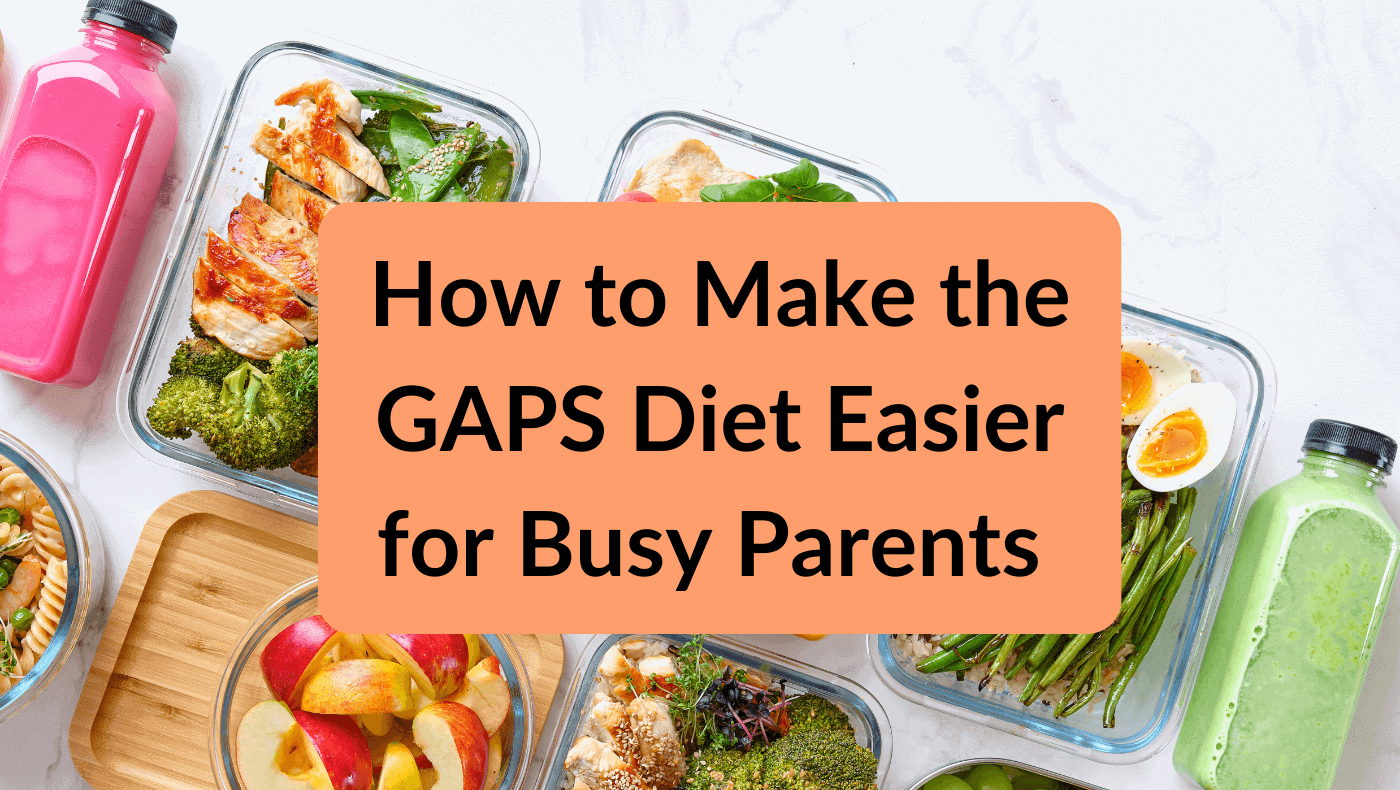Looking for GAPS diet tips for busy parents? Starting the GAPS diet can feel overwhelming, especially for busy parents juggling work, school runs, and family life. The GAPS (Gut and Psychology Syndrome) diet is designed to support gut healing, improve digestion, and assist with autoimmune or neurological issues.
While its health benefits are widely recognized, committing to this meal plan can be challenging due to the extensive meal prep, avoiding processed foods, and dealing with picky eaters at home.
With the right strategies, tools, and mindset, following the GAPS diet can feel easier and less overwhelming.
This blog will provide you with practical GAPS diet tips for busy parents, like me, and time-saving hacks to simplify your GAPS journey, so you can focus on both your family and gut health.
Plan Ahead: Meal Prep Plan for Success
Why Planning is Essential on the GAPS Diet
Planning is the foundation of success on the GAPS diet. Without it, busy parents are more likely to reach for processed foods or quick meal fixes that don’t align with the diet’s guidelines. By carving out time each week to plan and prepare meals, you’ll reduce stress and be ready to handle even the busiest days.
Time-Saving Meal Prep Tips
Here’s how to prep without overburdening yourself:
- Batch Cooking: Prepare broths, soups, and casseroles in large quantities. They freeze well and can be easily reheated for instant meals during the week.
- Use Kitchen Tools Wisely: Invest in an Instant Pot or slow cooker, which makes cooking broths and other labor-intensive dishes much faster.
- Pre-Chop and Freeze Vegetables: Spend one evening a week washing, chopping, and freezing vegetables to save time during meal prep.
- Create a Weekly Menu: Outline specific meals for the week and only buy ingredients you need, avoiding waste and reducing last-minute decisions.
How to Use an Instant Pot as a Slow Cooker
The Instant Pot offers a convenient way to replace a traditional slow cooker, and using it is surprisingly simple once you understand the settings.
- Start by selecting the right lid—use the regular Instant Pot lid and ensure the steam release valve is set to the “Venting” position to avoid building pressure.
- Next, prepare your ingredients and select the “Slow Cook” function on the control panel. Be mindful of the heat settings, as the Instant Pot defaults to “Normal,” which is equivalent to medium heat on a traditional slow cooker. If a recipe calls for low or high heat, adjust the settings accordingly using the “+” or “-” buttons.
- Finally, set the cooking time according to your recipe and allow the Instant Pot to work its magic. With these steps, you can enjoy all the benefits of slow cooking without the need for an additional appliance!
Must-Have Meal Prep Tools
- Instant Pot or Slow Cooker for quick and flavorful cooking.
- Glass Meal Prep Containers to store pre-prepped ingredients and leftovers.
- High-Powered Blender for gut-healing smoothies or pureeing GAPS soups.
GAPS-Friendly Broths & Shortcuts
The Importance of Broth in the GAPS Diet
Broth is a core component of the GAPS diet, supporting gut health by delivering essential nutrients, collagen, and minerals. However, making broth at home can be time-consuming for parents managing a busy schedule.
Quick Bone Broth Hacks for Busy Parents
- Faster Cooking with a Pressure Cooker: Using an Instant Pot or pressure cooker can help you make flavorful bone broth in under 2 hours, instead of simmering it all day.
- Freeze in Portions: Pour broth into ice cube trays or small silicone containers for easy single-use portions.
- Last Resort Options: If you’re in a pinch and need something quick, consider ready-made broths like Kettle & Fire or Bonafide Provisions. While not fully GAPS-compliant, they can work as a temporary solution when homemade isn’t an option.
Pro Tip: Always check labels to ensure store-bought broths meet GAPS guidelines, avoiding additives and preservatives.
Making Probiotic Foods Easy
Why Probiotics Matter for Gut Healing
Probiotic-rich foods like fermented vegetables, kefir, and sauerkraut are essential to the GAPS diet, as they help balance gut bacteria and improve digestion.
They’re particularly beneficial for kids who might struggle with gut issues or autism-related symptoms.
Easiest Ways to Include Fermented Foods
- Homemade Fermented Foods: If time permits, try fermenting your own vegetables or kefir at home. It’s cost-effective and fun for the kids to help!
- Kid-Friendly Choices: Introduce milder options like water kefir, yogurt, or lightly fermented cucumber pickles to entice picky eaters.
- Store-Bought Options: Look for pre-made sauerkraut, kimchi, or kefir at your local health food store. Ensure they are raw and unpasteurized. Be sure to check the labels for compliance with GAP diet.
GAPS Diet for Picky Eaters
How to Get Kids to Eat More GAPS-Friendly Foods
Feeding kids on GAPS can be tricky, but these clever methods can make it easier:
- Sneaky Broth Recipes: Add broth into soups, stews, or even spaghetti sauce for added nutrition.
- Gut-Healing Smoothies: Include kefir, plain yogurt, or even a dash of bone broth in their favorite smoothies.
- Fun Meal Ideas: Turn GAPS-compliant proteins like chicken thighs into kid-friendly nuggets or play with veggie noodles to mimic pasta.
Helpful Tip: Invest in a GAPS-friendly recipe book specifically catered to families with kids.
Must-Have GAPS Diet Staples & Where to Buy Them
Essential Pantry Staples
Stock your pantry with these GAPS must-haves for effortless cooking:
- Bone broth (homemade over store-bought).
- Fats like coconut oil, grass-fed ghee, and olive oil.
- Pastured meats, wild-caught fish, and organic eggs.
- Fermented vegetables like sauerkraut or kimchi.
Where to Buy:
- Online stores like Thrive Market or Amazon offer budgets for GAPS-compliant products.
- Local farmers’ markets are a great way to source seasonal ingredients affordably.
Simplifying the GAPS Lifestyle for Long-Term Success
How to Stick to GAPS Without Stress
Adopting the GAPS diet is a marathon, not a sprint. Use these strategies to avoid burnout:
- Rotate Meals: Avoid repetitive meal plans by rotating between soup-based, roasted, and stir-fried dishes.
- When Eating Out: Plan ahead by scanning restaurant menus for compliant options or bring your own prepped food.
- Get Support: Join GAPS-specific online communities or coaching programs to stay motivated and troubleshoot challenges. You can also request personalized coaching directly from me, a certified GAPS Practitioner, to help guide you through the process.
You’ve Got This!
The GAPS diet doesn’t have to be overwhelming, even for busy parents.
With a little planning, the right tools, and creative strategies, you can support your family’s health without sacrificing your sanity.
Start small, simplify your routine, and make adjustments as needed. Remember, every little step brings you closer to reaching your health goals.
If you’re ready to simplify meal planning, check out my GAPS-specific products in the store!
You’ll find all the recipes, tips, and guidance you need to succeed.





0 Comments